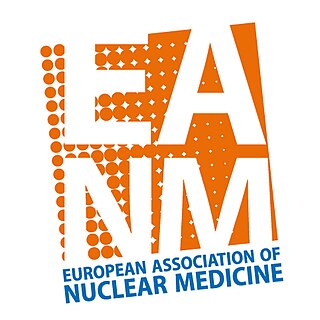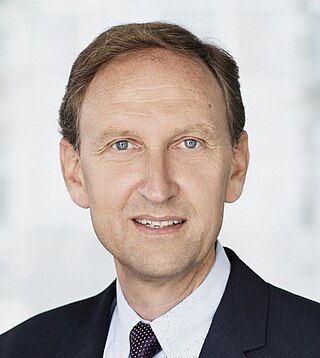Radionuclide therapy uses radioactive substances called radiopharmaceuticals to treat medical conditions, particularly cancer. These are introduced into the body by various means and localise to specific locations, organs or tissues depending on their properties and administration routes. This includes anything from a simple compound such as sodium iodide that locates to the thyroid via trapping the iodide ion, to complex biopharmaceuticals such as recombinant antibodies which are attached to radionuclides and seek out specific antigens on cell surfaces.

Nuclear medicine or nucleology is a medical specialty involving the application of radioactive substances in the diagnosis and treatment of disease. Nuclear imaging, in a sense, is "radiology done inside out" because it records radiation emitted from within the body rather than radiation that is transmitted through the body from external sources like X-ray generators. In addition, nuclear medicine scans differ from radiology, as the emphasis is not on imaging anatomy, but on the function. For such reason, it is called a physiological imaging modality. Single photon emission computed tomography (SPECT) and positron emission tomography (PET) scans are the two most common imaging modalities in nuclear medicine.

Iodine-131 is an important radioisotope of iodine discovered by Glenn Seaborg and John Livingood in 1938 at the University of California, Berkeley. It has a radioactive decay half-life of about eight days. It is associated with nuclear energy, medical diagnostic and treatment procedures, and natural gas production. It also plays a major role as a radioactive isotope present in nuclear fission products, and was a significant contributor to the health hazards from open-air atomic bomb testing in the 1950s, and from the Chernobyl disaster, as well as being a large fraction of the contamination hazard in the first weeks in the Fukushima nuclear crisis. This is because 131I is a major fission product of uranium and plutonium, comprising nearly 3% of the total products of fission. See fission product yield for a comparison with other radioactive fission products. 131I is also a major fission product of uranium-233, produced from thorium.

Personalized medicine, also referred to as precision medicine, is a medical model that separates people into different groups—with medical decisions, practices, interventions and/or products being tailored to the individual patient based on their predicted response or risk of disease. The terms personalized medicine, precision medicine, stratified medicine and P4 medicine are used interchangeably to describe this concept though some authors and organisations use these expressions separately to indicate particular nuances.
Iodine-123 (123I) is a radioactive isotope of iodine used in nuclear medicine imaging, including single-photon emission computed tomography (SPECT) or SPECT/CT exams. The isotope's half-life is 13.2230 hours; the decay by electron capture to tellurium-123 emits gamma radiation with a predominant energy of 159 keV. In medical applications, the radiation is detected by a gamma camera. The isotope is typically applied as iodide-123, the anionic form.

Iobenguane, or MIBG, is an aralkylguanidine analog of the adrenergic neurotransmitter norepinephrine (noradrenaline), typically used as a radiopharmaceutical. It acts as a blocking agent for adrenergic neurons. When radiolabeled, it can be used in nuclear medicinal diagnostic and therapy techniques as well as in neuroendocrine chemotherapy treatments.
The American Society of Clinical Oncology (ASCO) is a professional organization representing physicians of all oncology sub-specialties who care for people with cancer. Founded in 1964 by Fred Ansfield, Harry Bisel, Herman Freckman, Arnoldus Goudsmit, Robert Talley, William Wilson, and Jane C. Wright, it has nearly 45,000 members worldwide.
The American Board of Nuclear Medicine (ABNM) certifies physicians as specialists in the practice of nuclear medicine. Diplomates of the ABNM are called nuclear medicine physicians. The ABNM is one of the 24 member boards of the American Board of Medical Specialties (ABMS).
Nuclear medicine physicians, also called nuclear radiologists or simply nucleologists, are medical specialists that use tracers, usually radiopharmaceuticals, for diagnosis and therapy. Nuclear medicine procedures are the major clinical applications of molecular imaging and molecular therapy. In the United States, nuclear medicine physicians are certified by the American Board of Nuclear Medicine and the American Osteopathic Board of Nuclear Medicine.

Saul Hertz, M.D. was an American physician who devised the medical uses of radioactive iodine. Hertz pioneered the first targeted cancer therapies. Hertz is called the father of the field of theranostics, combining diagnostic imaging with therapy in a single or paired chemical substance(s).

The European Association of Nuclear Medicine (EANM) is the leading professional organisation for nuclear medicine in Europe. Established in 1985, the EANM serves as an umbrella organisation comprising national societies, affiliated societies and individual members working in nuclear medicine or related fields. It is also dedicated to the promotion of nuclear medicine amongst other medical learned societies, EU institutions like the European Union, international organisations like the International Atomic Energy Agency, and the general public.
Appropriate use criteria (AUC), sometimes referred to as appropriateness criteria (AC), specify when it is appropriate to perform a medical procedure or service. An "appropriate" procedure is one for which the expected health benefits exceed the expected health risks by a wide margin. Ideally, AUC are evidence-based, but in the absence of sufficient evidence, may be derived from a consensus of expert opinion. AUC are typically classified in terms of the quality of the evidence on which they are based. In general, AUC are promulgated by medical specialty organizations. The definition of "appropriate" is subject to interpretation. For example, a key issue is whether or not a procedure or investigation can be deemed appropriate if it does not result in a change in management.
Sandip Basu is an Indian physician of Nuclear Medicine and the Head, Nuclear Medicine Academic Program at the Radiation Medicine Centre. He is also the Dean-Academic (Health-Sciences), BARC at Homi Bhabha National Institute and is known for his services and research in Nuclear Medicine, particularly on Positron emission tomography diagnostics and Targeted Radionuclide Therapy in Cancer. The Council of Scientific and Industrial Research, the apex agency of the Government of India for scientific research, awarded him the Shanti Swarup Bhatnagar Prize for Science and Technology, one of the highest Indian science awards for his contributions to Nuclear Medicine in 2012.

Andreas Kjær is a Danish physician-scientist and European Research Council (ERC) advanced grantee. He is professor at the University of Copenhagen and chief physician at Rigshospitalet, the National University Hospital of Denmark. He is board certified in Nuclear Medicine and his research is focused on molecular imaging with PET and PET/MRI and targeted radionuclide therapies (theranostics) in cancer. His achievements include development of several new PET tracers that have reached first-in-human clinical use. He has published more than 400 peer-review articles, filed 10 patents, supervised more than 40 PhD students and received numerous prestigious scientific awards over the years. He is a member of the Danish Academy of Technical Sciences
Charis Eng is a Singapore-born physician-scientist and geneticist at the Cleveland Clinic, notable for identifying the PTEN gene. She is the Chairwoman and founding Director of the Genomic Medicine Institute of the Cleveland Clinic, founding Director and attending clinical cancer geneticist of the institute’s clinical component, the Center for Personalized Genetic Healthcare, and Professor and Vice Chairwoman of the Department of Genetics and Genome Sciences at Case Western Reserve University School of Medicine.
Jason S. Lewis is a British radiochemist whose work relates to oncologic therapy and diagnosis. His research focus is a molecular imaging-based program focused on radiopharmaceutical development as well as the study of multimodality small- and biomolecule-based agents and their clinical translation. He has worked on the development of small molecules as well as radiolabeled peptides and antibodies probing the overexpression of receptors and antigens on tumors.
The Association for Molecular Pathology is a professional association of individuals serving patients through molecular diagnostics testing. Founded in 1995, the Association has more than 2,800 members in over 50 countries.
A clinical technologist, also known as a healthcare science practitioner, is a medical professional involved in the practical delivery of medical physics and clinical engineering services. In some locations there is considerable overlap in closely related terms, for example in many countries technologist and radiographer are synonyms, while in the United Kingdom they are considered separate professions. Clinical technologists can be found in nuclear medicine, radiotherapy, radiation protection, and rehabilitation engineering departments, and they are often described by their scope of practice.
Theranostics, also known as theragnostics, is an emerging field in precision medicine that combines diagnostic and therapeutic approaches to provide the potential for personalized treatment and real-time monitoring of the effectiveness of treatments. Improvements in imaging techniques and targeted therapies are the basis of the field of theranostics. When medical imaging is coupled with the development of novel radiotracers and contrast agents, theranostics may provide opportunities for precise diagnosis and targeted therapy.







